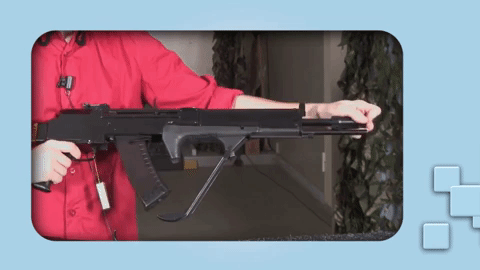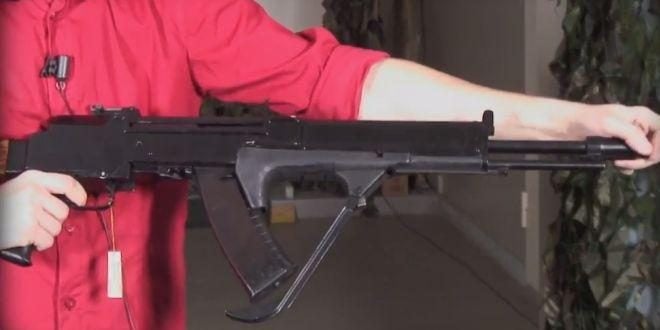The Kalashnikov Museum keeps releasing new videos showing some of the rarest experimental Soviet firearms. These videos provide a good visual reference of the basic mechanical features of these unusual rifles. They also allow writing an article based on them making it more understandable and interesting. This time they are telling about another pair of rifles called AS and ASM. Both are designed in Izhmash by Gennadiy Nikonov, who is more known as the designer of the AN-94 assault rifle. In fact, AS and ASM rifles are predecessors of the AN-94 and its delayed recoil impulse mechanism. Let’s watch the video (in Russian) first and then take a closer look at each of the rifles․
The way that the mechanism of these rifles work is that the actual rifle freely recoils inside an outer shell/chassis after the first shot of the 2-round burst. During this recoiling motion, the gun makes the second shot of the 2-round burst and only after that the moving parts hit the rear wall of the outer shell and transfer the recoil impulse to the shooter. It allows making a 2-round burst at a very high rate of fire which feels like a single shot. As a result, the two bullets hit the target in a very close proximity. If you want to learn more about this mechanism, I highly recommend watching one of the latest videos by Forgotten Weapons.
AS rifle
The AS rifle was Nikonov’s first design in the Abakan trials submitted in 1981. It has successfully passed the first stages of the trials and was suggested to be modified to later become the ASM rifle. The AS rifle has one very distinctive feature of the magazine moving with the action. Now, while the general idea of the delayed recoil impulse is interesting, the execution involving a moving magazine leaves a lot to be desired.
One of the problems with this design is that the action would have to work with the constantly changing mass of the magazine. The 30 round 5.45x39mm magazine’s mass can vary about 11 oz from being empty to fully loaded. That could lead to potential malfunctions and non-consistent rate of fire.
Another problem is the impossibility to use higher capacity magazines (e.g. 45 rounders of RPK-74). Higher capacity mags just won’t fit into that forearm extension. That’s too bad on its own because now you have magazine compatibility issues between the assault rifle and the light machine gun. Even if it was possible to fit the 45-rounder it would further increase the malfunction probability caused by the changing mass and balance described in the previous paragraph.

Another drawback is that if the magazine touches anything (e.g. the shooter’s hand) it may cause malfunctions. The long protrusion coming from the handguard back to the bottom of the magazine is there to allow to rest the gun on the ground. Normally, soldiers would rest the gun on the magazine when shooting prone (no matter what the manual says) and without that “magazine guard”, it wouldn’t allow the magazine to reciprocate.
So, I think despite they reached the desired ballistic performance, this rifle had poor mechanical solutions and it had no chances of being adopted.
ASM rifle
ASM is the modernized version of the AS rifle. They got rid of the reciprocating magazine idea and replaced it with the two stage feeding mechanism seen in AN-94. On one hand they solved the problems caused by the moving magazine, but on the other hand, it was done at a cost of further complicating the mechanism. ASM is almost exactly identical to the AN-94 rifle which was ultimately adopted.

This rifle also has the distinctive offset magazine found in AN-94 Abakan. That layout also causes some inconveniences with the magazine compatibility with the LMG. Not that it won’t take them, but just imagine a 45-rounder or a drum mag hanging at an angle – how awkward that will be?
Both rifles are chambered in 5.45x39mm cartridge and feed from standard AK-74 magazines. They have the firing modes of a single shot, 2-round burst (at 1800 rpm) and full auto. In the fully automatic mode, the rifles fire first two rounds at the 1800 rpm then go on firing at a rate of fire of 600 rpm. Some of the other Russian sources state that AS was capable of 3-round burst at a slightly higher rate of fire of 2000 rpm. Both the AS and ASM rifles are gas operated and have an action lockup accomplished by a rotating bolt.
Conclusion and some thoughts
My opinion on these rifles is that they reach a goal which doesn’t worth the costs and overcomplication of the mechanisms. Let me put it this way – is it that important to have that two round accurate burst at a cost of having a much more complicated (over the existing AK-74) rifle? And being simple is important for a military firearm. You just can’t (or can at an enormous cost) teach all soldiers to master the field stripping and putting back together a mechanism which rather looks like a puzzle. Also, simpler guns have fewer chances of malfunctioning in adverse conditions of the battlefield.
Now an argument can be raised stating that it could be issued to special operations units who should be better trained than an average infantry soldier and wouldn’t have a problem to master the mechanism. However, a counter argument is that these units should be better shooters too, so they could probably be as effective on the target with just an added possibility of 2 or 3 round burst on the conventional rifle.
Also, the idea of two shots placed close to each other is questionable too. I think it doesn’t increase the hit probability much because if you miss the target, the chances are high that you’ll miss with both bullets. It could make sense if the rounds had more spread, but then you’d have accuracy issue and/or no advantage over the conventional burst. The idea of hitting the target with two rounds simultaneously is also odd to me. If one round won’t kill/disable the enemy, then you have a problem with the cartridge’s terminal performance, to begin with. If it is a potent cartridge then do you want to kill the same enemy twice? Two bullets aren’t any better if one bullet does the job.
Of course mechanically and in terms of firearms design and development history these rifles are just treasures and it is extremely interesting to see how the designers came with different solutions and overcame the obstacles in the way of reaching the set goal. I also think that the balanced action was a much more practical solution in these trials. However, these are just my thoughts and they don’t necessarily have to be correct … so feel free to argue in the comments section!
 Your Privacy Choices
Your Privacy Choices
